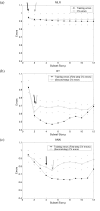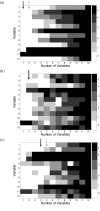A multivariate prediction model for microarray cross-hybridization
- PMID: 16509965
- PMCID: PMC1409802
- DOI: 10.1186/1471-2105-7-101
A multivariate prediction model for microarray cross-hybridization
Abstract
Background: Expression microarray analysis is one of the most popular molecular diagnostic techniques in the post-genomic era. However, this technique faces the fundamental problem of potential cross-hybridization. This is a pervasive problem for both oligonucleotide and cDNA microarrays; it is considered particularly problematic for the latter. No comprehensive multivariate predictive modeling has been performed to understand how multiple variables contribute to (cross-) hybridization.
Results: We propose a systematic search strategy using multiple multivariate models [multiple linear regressions, regression trees, and artificial neural network analyses (ANNs)] to select an effective set of predictors for hybridization. We validate this approach on a set of DNA microarrays with cytochrome p450 family genes. The performance of our multiple multivariate models is compared with that of a recently proposed third-order polynomial regression method that uses percent identity as the sole predictor. All multivariate models agree that the 'most contiguous base pairs between probe and target sequences,' rather than percent identity, is the best univariate predictor. The predictive power is improved by inclusion of additional nonlinear effects, in particular target GC content, when regression trees or ANNs are used.
Conclusion: A systematic multivariate approach is provided to assess the importance of multiple sequence features for hybridization and of relationships among these features. This approach can easily be applied to larger datasets. This will allow future developments of generalized hybridization models that will be able to correct for false-positive cross-hybridization signals in expression experiments.
Figures





Similar articles
-
Spatial normalization of array-CGH data.BMC Bioinformatics. 2006 May 22;7:264. doi: 10.1186/1471-2105-7-264. BMC Bioinformatics. 2006. PMID: 16716215 Free PMC article.
-
An improved physico-chemical model of hybridization on high-density oligonucleotide microarrays.Bioinformatics. 2008 May 15;24(10):1278-85. doi: 10.1093/bioinformatics/btn109. Epub 2008 Mar 31. Bioinformatics. 2008. PMID: 18378525 Free PMC article.
-
Assessing the need for sequence-based normalization in tiling microarray experiments.Bioinformatics. 2007 Apr 15;23(8):988-97. doi: 10.1093/bioinformatics/btm052. Epub 2007 Mar 25. Bioinformatics. 2007. PMID: 17387113
-
There is no silver bullet--a guide to low-level data transforms and normalisation methods for microarray data.Brief Bioinform. 2005 Mar;6(1):86-97. doi: 10.1093/bib/6.1.86. Brief Bioinform. 2005. PMID: 15826359 Review.
-
A Bayesian method for analysing spotted microarray data.Brief Bioinform. 2005 Dec;6(4):318-30. doi: 10.1093/bib/6.4.318. Brief Bioinform. 2005. PMID: 16420731 Review.
Cited by
-
Optimization of cDNA microarrays procedures using criteria that do not rely on external standards.BMC Genomics. 2007 Oct 18;8:377. doi: 10.1186/1471-2164-8-377. BMC Genomics. 2007. PMID: 17949480 Free PMC article.
-
Estimating the efficiency of fish cross-species cDNA microarray hybridization.Mar Biotechnol (NY). 2007 Jul-Aug;9(4):491-9. doi: 10.1007/s10126-007-9010-8. Epub 2007 May 20. Mar Biotechnol (NY). 2007. PMID: 17514486
-
In situ analysis of cross-hybridisation on microarrays and the inference of expression correlation.BMC Bioinformatics. 2007 Nov 26;8:461. doi: 10.1186/1471-2105-8-461. BMC Bioinformatics. 2007. PMID: 18039370 Free PMC article.
-
Optimization and clinical validation of a pathogen detection microarray.Genome Biol. 2007;8(5):R93. doi: 10.1186/gb-2007-8-5-r93. Genome Biol. 2007. PMID: 17531104 Free PMC article.
-
CrossHybDetector: detection of cross-hybridization events in DNA microarray experiments.BMC Bioinformatics. 2008 Nov 17;9:485. doi: 10.1186/1471-2105-9-485. BMC Bioinformatics. 2008. PMID: 19014642 Free PMC article.
References
-
- Lipshutz RJ, Morris D, Chee M, Hubbell E, Kozal MJ, Shah N, Shen N, Yang R, Fodor SP. Using oligonucleotide probe arrays to access genetic diversity. Biotechniques. 1995;19:442–447. - PubMed
-
- Schena M, Shalon D, Davis RW, Brown PO. Quantitative monitoring of gene expression patterns with a complementary DNA microarray. Science. 1995;270:467–467. - PubMed
-
- Ptijssen P. Laboratory Techniques in Biochemistry and molecular biology: hybridization with nucleic acid probes Part I: theory and nucleic acid preparation. Vol. 24. Amsterdam, The Netherlands , Elsevier Science Publishers BV; 1993. Overview of principles of hybridization and the strategy of nucleic acid probe assays; pp. 19–78.
Publication types
MeSH terms
Grants and funding
LinkOut - more resources
Full Text Sources
Other Literature Sources
Molecular Biology Databases
Miscellaneous

